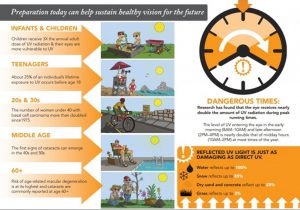As summer draws near, most of us long for the glorious warmth of the sun and we dream about, and plan for, the recreation we will enjoy. Unfortunately, while awareness of the importance of sunscreen and UV protective clothing has increased, the impacts of all that fun-in-the-sun on the eyes is still often overlooked. Most people do not realize that 20% of all cataracts are the result of UV ray exposure, and that number has been dramatically increasing in recent years.
But what is this invisible threat exactly? And how does it impact us? Ultraviolet radiation is measured in nanometers (nm). It is categorized in three basic terms and classified by the strength of the UV ray:
- UVC: These rays are below 280 nm. The upper atmosphere absorbs these so they do not reach us, therefore protection from these rays is not overly necessary.
- UVB: These are between 315 – 380 nm. These manage to make it to the earth’s surface and are notorious for damaging sight. They can cause snow blindness, but are notably responsible for sunburn and several types of skin cancer. Research has shown that these rays are strongest during the summer and at higher altitudes.
- UVA: These are the most dangerous being 315 – 380 nm. They are known for causing chronic eye damage. Studies have indicated that these rays get absorbed by the lenses of our eyes leading to damage of the retina. They contribute to the occurrence of cataracts, are also a major cause of aging and unfortunately can pass through clouds, glass, water and clothing.
But what about Vitamin D? A little sun exposure is healthy for us, right? Vitamin D is essential to help your body absorb calcium and promote bone growth. Vitamin D is also beneficial for other important body functions and it has been shown to be essential to a healthy immune system. However, just 5-15 minutes in the sun is enough to help stimulate the production of Vitamin D.
Prolonged UV exposure has numerous immediate and deleterious negative impacts. Many skin cancers can occur on the eyelids and external features of the eye. Additionally, while ocular melanoma is rare it is the most common eye cancer in adults. Because of the increasing number of UV related cataracts and eye cancers; Prevent Blindness, and many other organizations, strongly recommend that everyone utilize UV Protection eyewear, not only those who engage in outdoor disciplines and recreation. It is recommended that sunglasses and UV treated daily wear should be 100% UV absorbing for UVA and UVB light.
When we are caught up in the delightful pursuits of summer – particularly exuberant children – we tend to overlook the simple proactive measures that we can take to protect against vision loss and UV related eye damage and even life threatening ocular cancers. In addition to taking a few extra moments to protect yourself and your loved ones before rushing out into the sunshine, it is imperative that people take the time for annual eye exams. An optomap screening is an excellent, expedient way to get a comprehensive view of the retina and to gain essential information about ones ocular health. optomap is the only proven, clinically-validated, ultra-widefield retinal image that can capture 82% or 200⁰ of the retina, which can reveal incredibly subtle changes from the central pole to the far periphery of the retina in a single capture – and in a fraction of a second – so you can get out there (well-protected, of course) and enjoy that summer sun.
Visit our website to learn how optomap can assist your local eyecare professional in protecting your sight and general health.
